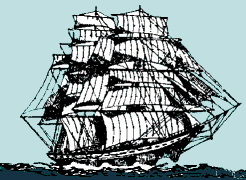Shanty Words, Shanty Definitions- The Sea Shanty .net
Shanty Words: Characters
Johnny- probably the term most often used in shantiesBoney- (from Boney was a Warrior) refers to Napoleon Bonaparte, Stan Hugill speculated that it had its origins in the street ballads of the Napoleonic Wars.
Santy Anna- "Another mystery is the fascination which Antonio Lopez de Santa Anna (1795-1876) exercised over the sailor. He was one of the many Mexican 'Presidents' and was defeated by the American General Taylor in 1847. That did not prevent the British sailor presenting him in the light of an invariable victor until he was led out to be shot (he really died a natural death) by persons unknown." *
Ranzo- "Who Ranzo was must ever remain a mystery. Capt. Whall suggests that the word might be a corruption of Lorenzo, since Yankee Whalers took many Portuguese men from the Azores, where Lorenzo would have been a common enough name. He adds that in his time the shanty was always sung to the regulation words, and that 'when the story was finished there was no attempt at improvization; the text was, I suppose, considered sacred.' " *
Stormy- Stormalong John
Jack Tar- slang for a sailor, it may have come from the tar-impregnated hats and raingear they wore or the ropes they hauled on, which were made waterproof with tar
Shanty Words: Places
 HiLo-
Stan Hugill says: "...we will now run through those worksongs woven
around the word 'Hilo'. Hilo is a port in the Hawaiian group, and, although
occasionally shellbacks may have been referring to this locality, usually
it was a port in South America of which they were singing--the Peruvian
nitrate port of Ilo. But in some of these Hilo shanties it was not a port,
either in Hawaii or Peru, to which they were referring. Sometimes the word
was a substitute for a 'do', a 'jamboree', or even a 'dance'. And in some
cases the word was used as a verb--to 'hilo' somebody or something. In
this sense its origin and derivation is a mystery. Furthermore, since shanties
were not composed in the normal manner, by putting them down, it is on
paper quite possible many of these 'hilos' are nothing more than 'high-low',
as Miss Colcord has it in her version of We'll Ranzo Ray. Take your pick!"
HiLo-
Stan Hugill says: "...we will now run through those worksongs woven
around the word 'Hilo'. Hilo is a port in the Hawaiian group, and, although
occasionally shellbacks may have been referring to this locality, usually
it was a port in South America of which they were singing--the Peruvian
nitrate port of Ilo. But in some of these Hilo shanties it was not a port,
either in Hawaii or Peru, to which they were referring. Sometimes the word
was a substitute for a 'do', a 'jamboree', or even a 'dance'. And in some
cases the word was used as a verb--to 'hilo' somebody or something. In
this sense its origin and derivation is a mystery. Furthermore, since shanties
were not composed in the normal manner, by putting them down, it is on
paper quite possible many of these 'hilos' are nothing more than 'high-low',
as Miss Colcord has it in her version of We'll Ranzo Ray. Take your pick!"Mobile Bay- the bay of Mobile, Alabama, US, this may have worked into shanties from land-based work songs
Rio Grande- "It has been suggested that it refers to the famous river on the Mexican border. It seems clear, however, that it was first sung in the Brazil trade and was inspired by the port and province of Rio Grande do Sul. Most version show plainly that the Rio Grande of the shanty was not simply a river, but a port or region; one version, for example, runs, "There the Portugee girls may be found." Usually known succinctly as "Rio Grande," the southern Brazilian province and its chief port, of the same name, carried on a busy trade with the United States and Britain, outdoing in this respect all of the many other Rio Grandes on the map." -William Doerflinger, Songs of the Sailor and Lumberman
Shenandoah- "Shenandoah (English seamen usually pronounced it 'Shannandore') was a celebrated Indian chief after whom an American town is named. A branch of the Potomac river bears the same name." *
Shanty Words: Ships and Sailing
Grog- named after Vice-Admiral Edward Vernon (and the grogram cloak he wore), a mixture of water and rum, the rum was an antiseptic and flavor mask for the spoiled water that sailors often had to drink while at seaWindlass- a barrel-shaped device laid on its side which was used to haul up or 'weigh' the anchor
Capstan- used like the windlass to haul the anchor, positioned vertically and turned with capstan bars or staves
Halyard (Halliard)- the large thick rope or 'line' used to hoist up sails and the yardarms which hold them
Pawl- the ratchet catch used on the gear of a windlass or capstan to hold the device from moving freely in both directions
Tacks- the ropes or lines attached to the lower corners of sails
Belaying Pin- a thick club-shaped rod made of wood, iron, brass, or steel used to secure the ropes and lines under load
Taffrail- the railing that runs around the stern or rear of the ship
Scuppers- channels or holes around the deck's edge designed to drain off rain and seawater
Blow- not a reference to wind, it is a euphemism for being kicked, struck, or knocked down
Sheet- the sails or more properly, the lines used to control the sails
Packet- swift ships than ran mail and passengers regularly between America and Europe, mainly Britain
* from The Shanty Book- Part I, by Richard Runciman
Terry, London, 1921
Shanty Words, Shanty Definitions- The Sea Shanty .net
About Shanties | Sea Shanties at Arrr.netAll content copyright ©2007-2014 The Sea Shanty
.net unless otherwise noted.
